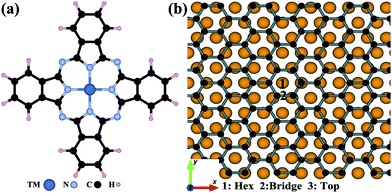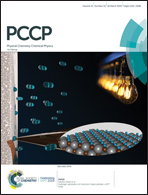Electronic and magnetic properties of CoPc and FePc molecules on graphene: the substrate, defect, and hydrogen adsorption effects†
Abstract
Transition metal phthalocyanines (TMPcs) are particularly appealing for spintronic processing and data storage devices due to their structural simplicity and functional flexibility. To realize effective control of the spins in TMPc-based systems, it is necessary to quantify how the structural and chemical environment of the molecule affects its spin center. Herein we perform a detailed investigation of the electronic and spintronic properties of vertically stacked heterostructures formed by CoPc or FePc adsorbed on a monolayer of graphene under the influences of the gold substrate, vacancies in graphene, and extra atomic hydrogen coordination on the TMPc. By using density functional theory (DFT), we reveal that both the TMPc molecules prefer the carbon-top position on graphene, and the existence of the Au substrate enhances the stability of the adsorption, while this enhanced adsorption will not modify the molecular magnetism, keeping it the same value as in the free standing case. Moreover, with the aid of a combination of DFT and ab initio wavefunction-based calculations, our results indicate that the magnetic anisotropy of the FePc–graphene complex can be actively tuned by the Au substrate. Our calculations also show that defects in graphene including single and double vacancies can modify the magnetism of these heterostructures. In particular, the spin state of FePc can be tuned from S = 1 to S = 2 with such defect engineering. Further spin state tunability can be achieved from a hydrogenation process, with the coordination of one extra hydrogen on the Co-top site for CoPc and the pyridinic N site for FePc, respectively, tuning their spin states from S = 1/2 to S = 0 and from S = 1 to S = 2. These findings may prove to be instrumental for rational design of future molecular spintronics devices integrated with two-dimensional materials.

- This article is part of the themed collection: 2019 PCCP HOT Articles


 Please wait while we load your content...
Please wait while we load your content...